 6 Emails That Re-Engage Customers & Promote Loyalty
6 Emails That Re-Engage Customers & Promote Loyalty
By Logicbroker | March 27, 2020
Guest Blog from Omnisend
So many email marketers are far too focused on subscriber count that they unwittingly miss out on opportunities to generate more sales. While your subscriber base is undeniably crucial to the success of any email marketing campaign, a revenue-focused marketer would put as much effort into re-engaging customers as generating opt-ins.
Theoretically, it’s an easy concept to understand. It’s always been said that it’s cheaper to take care of old customers than to keep chasing after new ones. But how true is that? The numbers might surprise you.
Essential Customer Retention Statistics
Mounting statistical evidence from a wide variety of credible sources shows that customer retention really is more productive than customer acquisition. For email marketers, here are some of the most useful data to consider when developing your campaigns:
- In most industries, only 5-20% of new prospects will complete a purchase while the probability of selling to an existing customer is up to 70%. [Marketing Metrics via Forbes]
- Customer acquisition costs 5% more than customer retention. [Forrester Research via The National Law Review]
- Existing customers make up approximately 65% of a company’s business. [Small Business Trends]
- About 80% of the profits your business will make in the future will come from 20% of the customers you already have. [Gartner via Salesforce Blog]
- Existing customers spend approximately 33% more than first-time buyers. [Laura Lake via Retention Science
- Making efforts to increase customer retention by at least 5% can result in a profitability boost of 75% [D&B Hoovers] or even up to 95% [Bain & Company].
- Increasing customer retention rates by 2% affects your bottom line the same way a 10% cost reduction would. [Murphy & Murphy via TDT Analytics]
- Order confirmation emails generate the highest click rate – 18.69% [Omnisend Annual Report]
- Email and SMS are the most commonly used platforms for customer retention, undoubtedly because of their effectiveness and cost-efficiency. [InvespCRO]
Luckily, some of the most powerful email marketing tools will allow you to create a series of automated workflows that will essentially put your entire re-engagement campaign on autopilot. The most crucial part of your task is to determine the most essential post-purchase emails to use in your marketing strategy.
Post-Purchase Emails That Drive Repeat Purchases
There are a number of post-purchase sequences you can set to re-engage customers and promote loyalty. But, here are six key emails that have proven to nurture customers, boost conversions, and generate repeat sales:
1) Confirm the order.
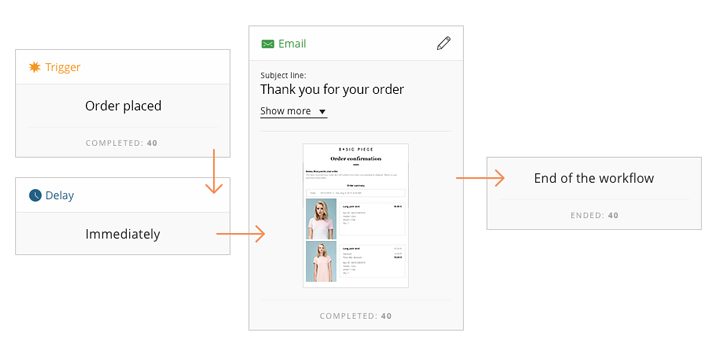
According to research by global research firm Gartner, Inc., 89% of all businesses believe that the primary basis for competition today is customer experience. You don’t necessarily need to offer the best products. To win against your competitors, your customer service needs to be stellar. And, possibly the most essential tool for guaranteeing an excellent customer experience is the automated order confirmation email.
Automatically confirming an order is crucial because you want your buyer to feel at ease about their decision to trust you, not just with their money but their data as well. You can craft this email in any way that suits your brand. But, you need to make sure it addresses the most apparent concerns any online buyer would have:
- A clear statement that their order went through.
- An idea of when they’ll receive the shipment.
- A receipt of payments made.
- How to get support in case they need it.
- What the next steps are.
Completing these details allow you to address their possible concerns, manage their expectations, and enhance their opinion of your brand all in a single automated email.
2) Confirm the shipment.
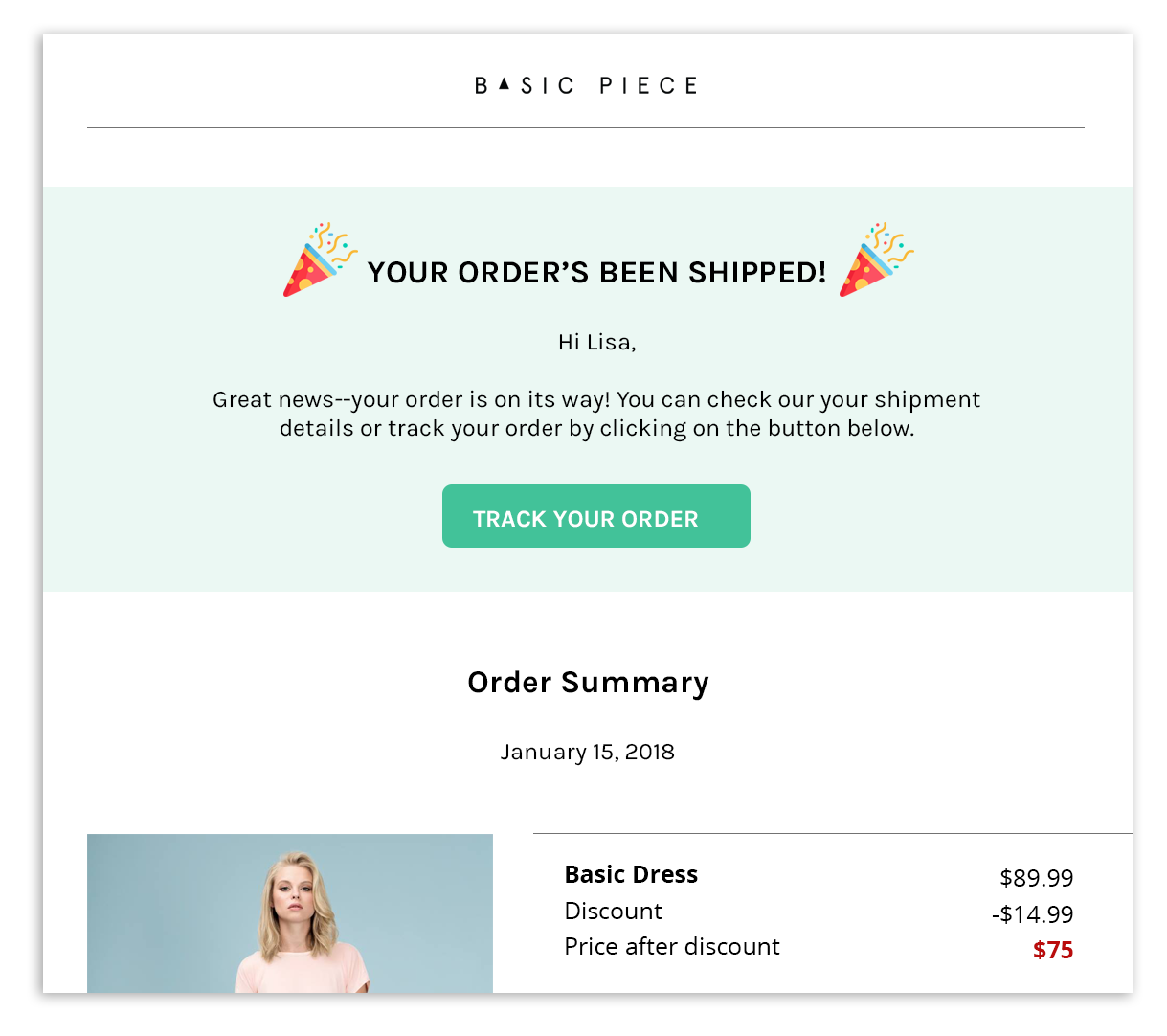
Whether through deceit, incompetence, or sheer bad luck, too many online purchases end with buyers apparently waiting for nothing. So, you can’t blame people for their need to be reassured at every step.
While most email marketers end their post-purchase workflows at the order confirmation email, the value of going a step further is undeniable.
The shipping confirmation email gives you a legitimate excuse to get in touch with your customer again. And for this, the rules about limiting email frequency don’t follow because it is a transactional email that’s most welcome after a purchase. But, if used correctly, it is also an opportunity to nurture your relationship further and court their trust.
In this email, the most important details include
- A clear statement that their order was already shipped.
- An update on when they should expect their purchases.
- A way to track their package.
- A way to keep in touch.
Through this email, you keep them at ease and further gain their trust. It could also be your best opportunity to provide additional information or advice that would enhance their experience when their package arrives.
3) Check on the shipment.
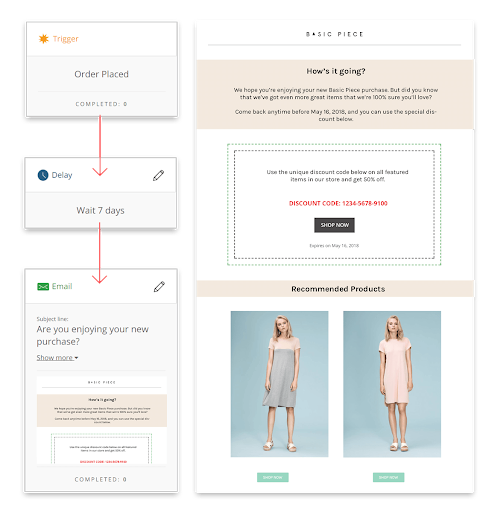
Set up an automated workflow to check on your customers a few days after their shipments were scheduled to arrive. According to Customer Thermometer, satisfied customers tell an average of 3 people about their positive experience. On the other hand, unhappy customers inform 10 people about their dissatisfaction. Thankfully, customers are generally satisfied as long as they feel they’ve been treated fairly, even if things don’t ultimately go their way.
This email should be incredibly simple. It doesn’t need to be a thorough review of your services. It should just let them know you care and that they can come to you for help if they’re not entirely happy. Ask questions like:
- Has your package arrived?
- Did your package arrive on time?
- Was your package in good shape?
- Are you happy with your purchase?
If all is good with their order (which should be the case majority of the time), the shipment check-in is yet another perfectly good excuse to reach out to your buyers and simply let your presence be felt.
If for any reason, something went wrong or they’re not completely satisfied with their experience, the check-in email gives you an opportunity to rectify all concerns before they end up publicly criticizing your brand. Additionally, this single email further shows your dedication to ensuring their satisfaction and how much you value them as a customer.
4) Ask for a review.
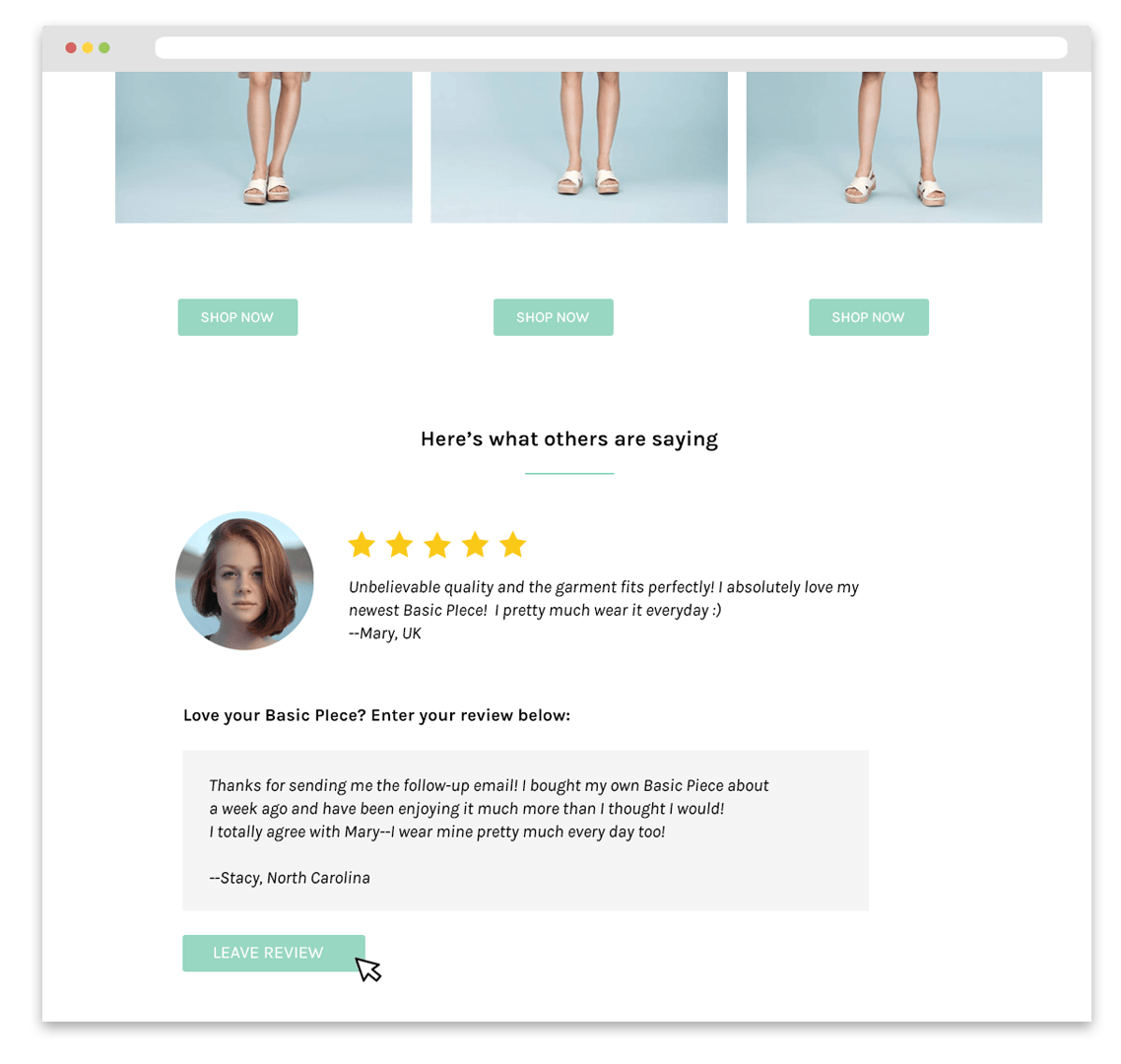
As you know, positive reviews bring in sales, while negative reviews have the capacity to kill a brand. But, if you’re sending this after the shipment check-in, dissatisfied customers have already had the chance to express their displeasure. And, you would have already had the opportunity to address that.
If you ask for a review at this point, chances are, it’s going to be a good one. The best part is that customers who rate you 5 out of 5 are six times more likely to become repeat customers.
Depending on the nature of your business, it might be a good idea to set this email to send after they’ve had enough time to really try their purchases. In this email, it’s good practice to:
- Use a good image of the product you provided.
- Describe the process and how much effort it involves.
- Show how other customers answered.
- Mention how a review will benefit them.
5) Send a re-order incentive.
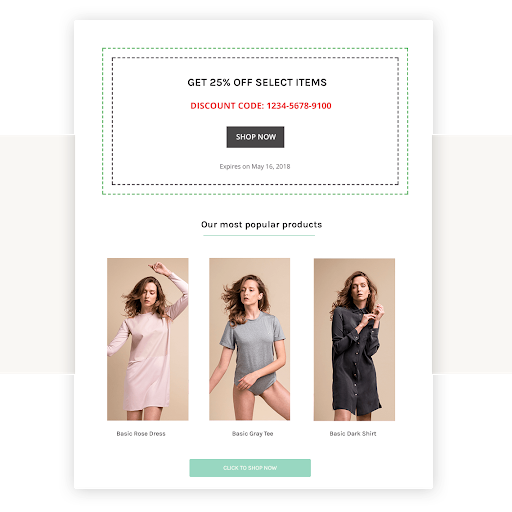
Satisfied customers are already likely to make an additional order. Why not give them a nudge by offering an incentive? Discount coupons are probably the most appreciated re-engagement incentives, but feel free to be creative. No matter what you’re offering, you’ll want the re-order incentive email to include:
- A reminder of their previous purchase.
- If they gave a review, a subtle reminder of their good experience with you.
- A limited-time incentive.
- A clear way to avail of the offer.
Additionally, you could also include pictures of products that are similar to ones they have previously purchased. That makes them all the more likely to shop again.
6) Recommend new products.
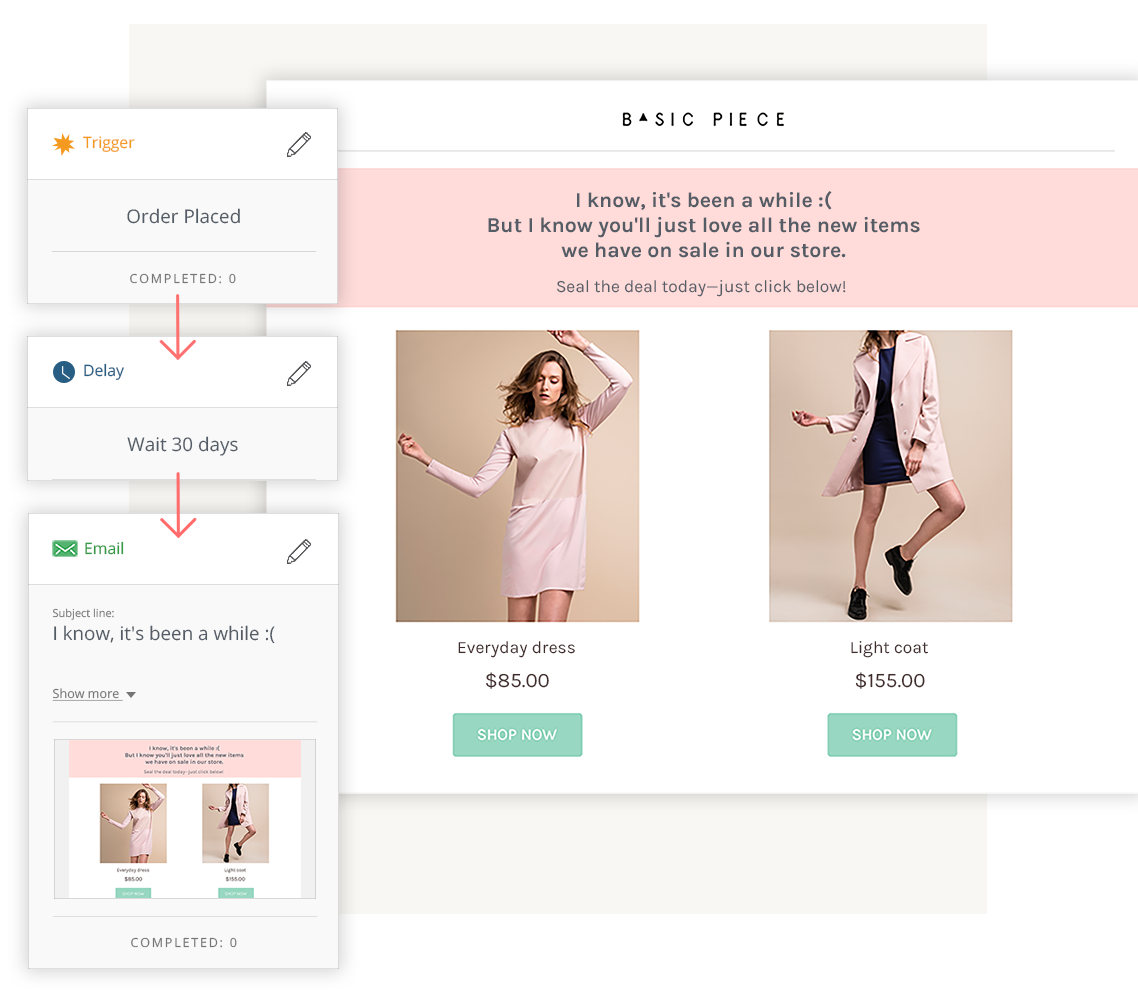
According to research by InvespCRO, existing customers are 50% more likely to try new products. You can take advantage of that fact by sending a reactivation email at least a month after their last purchase. Use this opportunity to show them new products they might be interested in.
In this email, try to include:
- An acknowledgment that time has passed since your last interaction.
- Products from categories they’ve shown interest in.
- A strong call-to-action to prompt a purchase.
Ideally, this email would trigger a purchase. But even if they don’t end up buying immediately, they might visit your site and re-engage. Or, they could simply be reminded of positive feelings about your brand. Either way, it helps boost your business.
Re-engaging customers is an incredible opportunity to boost profits while keeping marketing expenses low. All it takes is a cleverly crafted series of automated workflows composed of well-timed emails that effectively engage customers enough to keep them in a purchase loop.
Repeat customers are also more likely to advocate and recommend your brand, which eventually leads to exponential sales. Given all that, is there still any doubt that post-purchase emails could be the most powerful weapon in your digital marketing arsenal?
Modern dropship & marketplace solutions have never been so easy.
Are you ready to drive growth and gain unparalleled speed to market with a modern, scalable dropship or marketplace program? Fill out the form below to get in touch with our team: